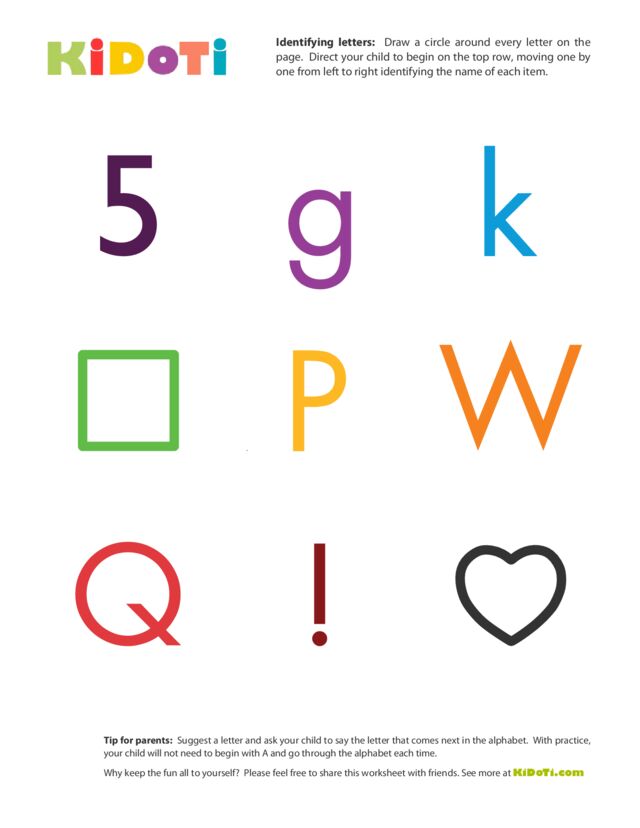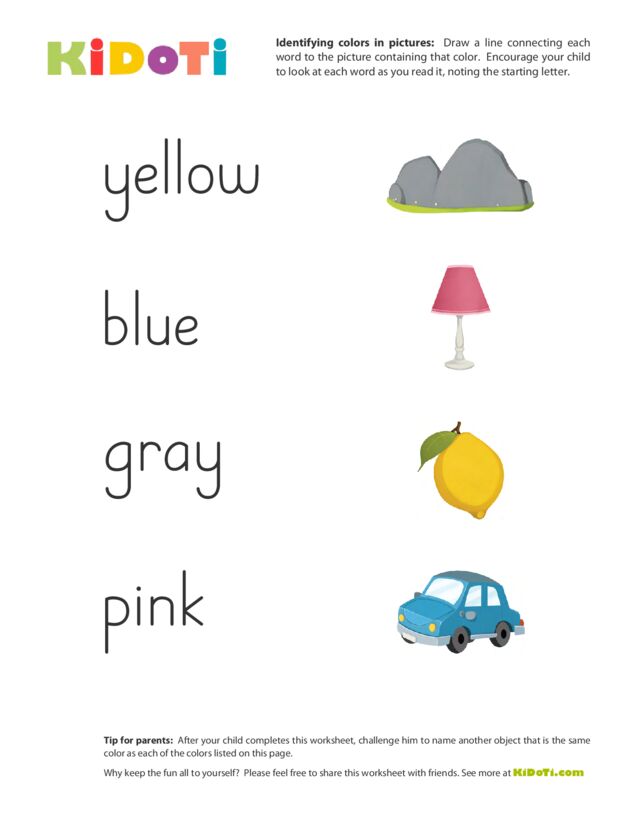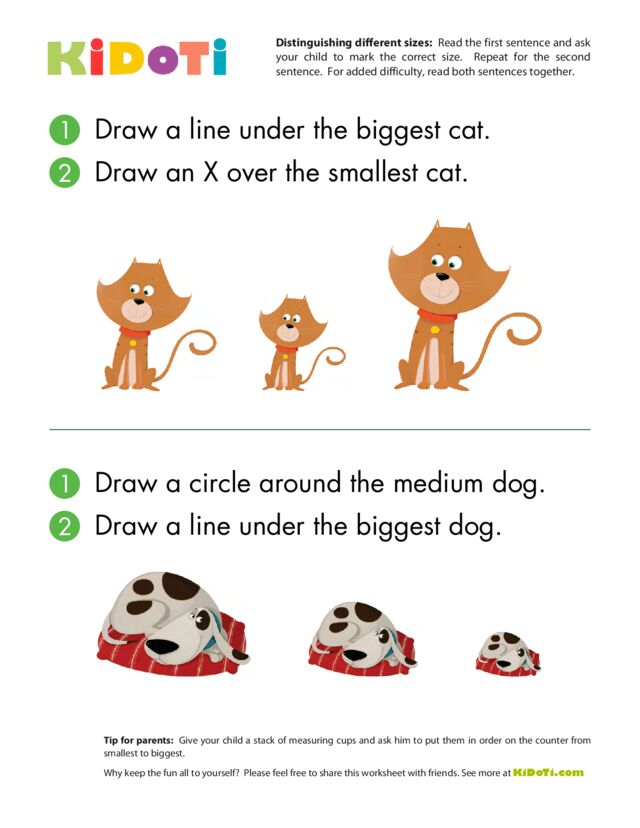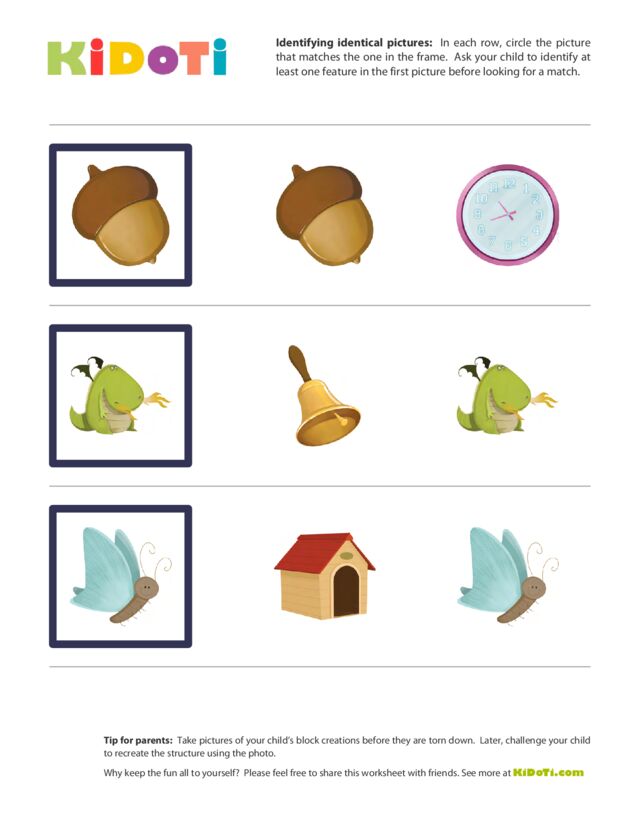Many parts of the classroom require strong visual discrimination skills. For example, your child will need to distinguish between a D and a B when reading and the numbers 10 and 100 are very different answers when counting. Also, as a teacher demonstrates an activity, your child will need to observe the demonstration and follow each individual step in the process.
Matching Pictures to Shadows
Identifying Letters
Learning Colors
Distinguishing Different Sizes
Identify Identical Picture
The importance of kindergarten visual discrimination worksheets
Visual discrimination skills play a tremendous role in learning for children of all ages. But these skills are especially important as children learn to read, to write and to work with numbers. Each letter and each number has its own unique shape that must be recognized by children so that they can be comfortable and confident readers, writers and mathematicians! Many letters and numbers have similar appearances – as the B, P and R, for example, or the 6 and 9 or 1 and 7. Strong visual discrimination skills are necessary to be able to distinguish subtle differences in letters, numbers and words (such as eat and cat, for instance).
Visual discrimination skills are also important when children observe demonstrations during classroom lessons and in many learning situations. All aspects of math, including patterning, counting, sorting and graphing depend on keen visual discrimination skills. In fact, it is difficult to think of a curriculum area where learning does not rely on visual discrimination skills.
The kindergarten visual discrimination worksheets featured in this section help children recognize the importance of making careful observations. In each set of worksheets, your child will be asked to look at each picture very carefully and notice small details.
In the first set of visual discrimination worksheets, children will focus their attention to the colors in the pictures. They can circle any picture that has the designated color in it. So careful observation will be required. In the second set of color worksheets, children will be asked to notice the color and also to look carefully at the color words. Visual discrimination skills with be called on to recognize the different letters in the color words. Since the beginning letter of the word can be a strong clue, it will be necessary for children to notice the difference between the p in purple, for example, and the b in black.
The compare and contrast worksheets and the matching pictures to shadows worksheets also provide practice noticing details in pictures, which requires strong visual discrimination skills.
The identifying letters worksheets begin by showing children that letters are specific symbols, not just random designs. As your child learns the uppercase and lowercase letters in the alphabet, he will be able to distinguish letters from other marks. Then words are added to the worksheets and children can learn to identify a group of letters as a word. When learning to read, children will have to identify separate words and notice each letter in a word, and these worksheets provide wonderful opportunities for honing this skill.
Tips for using these kindergarten visual discrimination worksheets
As with all the kindergarten worksheets your show your child, it is much better to set your child up for success by starting with the least challenging worksheet level. You can quickly advance to more challenging worksheets if your child races through the easier levels. However, while he is quickly completing the first worksheets, he will be gaining confidence while practicing basic skills.
As your child approaches these visual discrimination worksheets, encourage him to talk aloud about the details in the pictures he is looking at. The more your child talks about the images he sees, the more details he will be noticing, and talking aloud helps to commit something to memory.
Each set of visual discrimination worksheets asks your child to focus in on different characteristics of the illustrations on the page. Begin by showing your child the matching shadows worksheets, as these pages require children to simply notice the overall shape of the pictures. The color worksheets ask children to notice the colors in the illustrations. Some pictures are saturated with the designated color while others require closer investigation. Again, encourage your child to talk about the details he sees.
The next level of difficulty comes with the sheets that require children to match identical pictures. Here, looking at the details in the entire illustration will be important. Finally, the visual discrimination worksheets that ask children to notice the difference in sizes will require children to pay careful attention to the sizes of the identical illustrations.
Extra activities to help your child develop strong visual discrimination skills
In addition to completing these visual discrimination worksheets, you can encourage your child’s development of strong visual discrimination skills with small games or activities throughout the day.
- When your child is eating breakfast, read a picture book and ask him to point out details in the illustrations. Since you will be reading aloud and he will only be pointing to pictures, he will easily be able to continue eating while you complete this activity. Also, I’ve found that having an activity to work on while at the table helps keep young children in their seat for a longer period of time than if there was nothing to do at the table besides eat.
- Direct your child to find a particular shirt in his closet by identifying the colors or designs on it. Or, when your child is playing with his toys, direct him to work with specific pieces using descriptive phrases. For example, you could ask him to take the blue car to the top of the garage or place the long, yellow block on top of the square red block.
- Shopping can also be an opportunity for your child to practice visual discrimination skills. In the grocery, for instance, describe an item within his reach and ask your child to find it and put it in your cart. Or, play “I Spy” and have your child give you clues about an item he spies on the shelf and you need to find it based on the clues he gives you.




